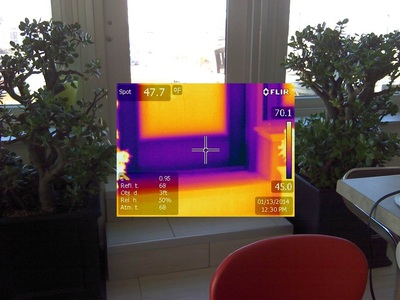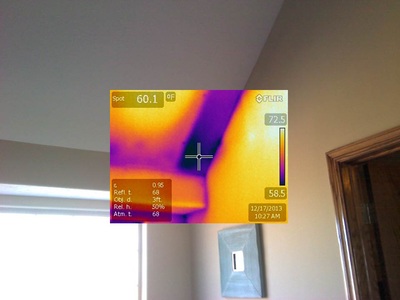Energy Evaluations
We prove several levels of energy audits for commercial buildings to meet your needs. Anything from a utility analysis or benchmarking to a full scale, investment grade energy audit. One of our core values is that all building owners/users should be able to afford an energy audit and energy management plan. As a private building owner or tenant, your utility bill is your largest single building operating cost, often accounting for more than 30% of your total building operating costs. In the past, many companies have just considered high utility costs as “a cost of doing business.” But running an inefficient building or business space just hurts your bottom line. It just doesn’t make any sense. We
will tailor our services to fit your investment and
maintenance goals whether you are the building owner or the tenant.
We understand the argument that if your tenants are paying the utility bills, then there is no reason to invest money in making your building energy efficient. After all, you won’t be reaping any energy savings. Keep in mind that increasing the energy efficiency of your building will increase in value. If you have a “green” building, your tenants will be happy to pay higher rents to occupy your building. On average for every dollar spent in energy efficiency improvements, appraised building value increases several times.
During the energy audit, an energy auditor will visit your site and interview your facility manager, inspect your building envelope, insulation levels, air sealing, windows, roof, lighting, air conditioning, heating and ventilation equipment, controls, refrigeration, air compressors, water consuming equipment, and anything else that is using energy. Depending on the type of the audit, the auditor may take measurements of temperatures, pressures, light levels, power draw, and other things.
An energy audit report typically contains a description of the building’s existing energy consuming equipment, an energy balance and most importantly, a presentation of feasible energy conservation measures (ECMs). Each of these measures are developed so that the report includes :
We provide benchmarking and perform ASHRAE Levels 1, 2, and 3 energy audits.
The ASHRAE Level 1 audit is walk-through audit that will identify energy efficiency measures (EEMs) while limiting the necessary engineering time and costs to produce the report. The estimated savings and costs associated with each measure are of rough order magnitude. The brief report focuses on low-cost and no-cost measures, although capital measures are identified when found. The report also includes a summary of utility data, the estimation of savings associated with a rate change, the calculation of the energy use index, benchmarking, and targeting. A small building will use very little energy, and will likely contain very little energy savings potential. For these small buildings, an ASHRAE Level 1 audit is probably best. We often perform ASHRAE Level 1 audits for clients who are seeking LEED-EB status. ASHRAE Level 1 audits are required as a prerequisite to attain LEED-EB status.
The ASHRAE Level 2 audit is more detailed and requires proficiency and thought to create a quality audit report. The Level 2 audit includes a complete description of the facility, including an equipment inventory, an energy balance, detailed energy savings and costs associated with each low-cost and not-cost measure, financial analysis of each recommended measure, identification and rough estimates of capital project costs and savings, and a recommended measurement and verification plan for each recommended measure. The Level 2 audit is the most likely type of energy audit for larger buildings. The Level 2 audit balances the need for engineering rigor with the need to keep auditing cost effective. The additional accuracy afforded by the Level 3 audit may not be worth the additional cost.
The ASHRAE Level 3 audits, often called Investment Grade Audits (IGA), are designed to provide additional engineering rigor for more expensive capital projects where risk is less tolerated. In these audits, trend logs and data loggers are used to better understand how the buildings react to changes in ambient conditions and occupancy. Calculations for HVAC measures are done with hourly simulations. Detailed costing estimates are provided, as are life cycle cost assessments. Typically a scope of work and schematics are provided with the audit so that the contractors installing the measures understand exactly what is to be installed. The reports contain more detailed descriptions of the measures.
If you are interested in receiving a commercial energy audit, energy evaluation, utility analysis, or benchmarking, please complete the contact form below and someone will contact you within 24 hours. You can also contact us at 402-213-3788.
We understand the argument that if your tenants are paying the utility bills, then there is no reason to invest money in making your building energy efficient. After all, you won’t be reaping any energy savings. Keep in mind that increasing the energy efficiency of your building will increase in value. If you have a “green” building, your tenants will be happy to pay higher rents to occupy your building. On average for every dollar spent in energy efficiency improvements, appraised building value increases several times.
During the energy audit, an energy auditor will visit your site and interview your facility manager, inspect your building envelope, insulation levels, air sealing, windows, roof, lighting, air conditioning, heating and ventilation equipment, controls, refrigeration, air compressors, water consuming equipment, and anything else that is using energy. Depending on the type of the audit, the auditor may take measurements of temperatures, pressures, light levels, power draw, and other things.
An energy audit report typically contains a description of the building’s existing energy consuming equipment, an energy balance and most importantly, a presentation of feasible energy conservation measures (ECMs). Each of these measures are developed so that the report includes :
- a description of the existing conditions
- a description of the proposed ECM
- expected annual savings associated with the ECM
- expected cost to implement the ECM
- simple payback and/or other financial measures, such as return on investment or life cycle savings
We provide benchmarking and perform ASHRAE Levels 1, 2, and 3 energy audits.
The ASHRAE Level 1 audit is walk-through audit that will identify energy efficiency measures (EEMs) while limiting the necessary engineering time and costs to produce the report. The estimated savings and costs associated with each measure are of rough order magnitude. The brief report focuses on low-cost and no-cost measures, although capital measures are identified when found. The report also includes a summary of utility data, the estimation of savings associated with a rate change, the calculation of the energy use index, benchmarking, and targeting. A small building will use very little energy, and will likely contain very little energy savings potential. For these small buildings, an ASHRAE Level 1 audit is probably best. We often perform ASHRAE Level 1 audits for clients who are seeking LEED-EB status. ASHRAE Level 1 audits are required as a prerequisite to attain LEED-EB status.
The ASHRAE Level 2 audit is more detailed and requires proficiency and thought to create a quality audit report. The Level 2 audit includes a complete description of the facility, including an equipment inventory, an energy balance, detailed energy savings and costs associated with each low-cost and not-cost measure, financial analysis of each recommended measure, identification and rough estimates of capital project costs and savings, and a recommended measurement and verification plan for each recommended measure. The Level 2 audit is the most likely type of energy audit for larger buildings. The Level 2 audit balances the need for engineering rigor with the need to keep auditing cost effective. The additional accuracy afforded by the Level 3 audit may not be worth the additional cost.
The ASHRAE Level 3 audits, often called Investment Grade Audits (IGA), are designed to provide additional engineering rigor for more expensive capital projects where risk is less tolerated. In these audits, trend logs and data loggers are used to better understand how the buildings react to changes in ambient conditions and occupancy. Calculations for HVAC measures are done with hourly simulations. Detailed costing estimates are provided, as are life cycle cost assessments. Typically a scope of work and schematics are provided with the audit so that the contractors installing the measures understand exactly what is to be installed. The reports contain more detailed descriptions of the measures.
If you are interested in receiving a commercial energy audit, energy evaluation, utility analysis, or benchmarking, please complete the contact form below and someone will contact you within 24 hours. You can also contact us at 402-213-3788.


